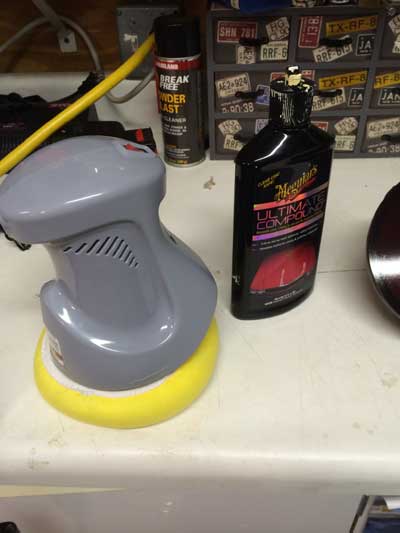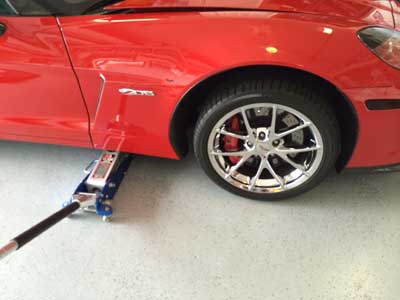Plastic Surgery
In an effort to update the look of our "Z" car it was
decided that a face lift via the modern blacked out look that is so
popular with the Euro racer crowd might be the ticket. In a previous
DIY article we showed you how to black out the side markers and equip
them with very neat looking LED's.
In keeping with this penny
pinching do it yourself mentality we decided to do the same thing to
rear lights. It would have been easy enough to shell out a hundred
bucks for a set of stick on acrylic covers. We decided to pocket
the change and do it ourselves. The only expense was an eight dollar
can of Rust-oleum lens tint. This stuff works great and we highly
recommend it versus other brands of lens tint that are available.
When
applied correctly the tint will yield a factory look and will not
significantly reduce the brightness of your lights. We do have to
qualify this by saying that it may be illegal to tint your lights
depending on your location. Tinted lenses are only recommended for show
and off road vehicles.
It is dangerous to over tint your rear
lights as too much product will cut down the visibility and will create
a hazardous condition. In other words do this mod at your own risk.
The
first thing you need to do is to remove the four rear lenses. Using a
no.15 torx bit unscrew the single screw at the top of each lens. Remove
the lens from the body housing and disconnect the connectors. Make sure
you keep track of the two outer and two inner lights as they have to be
replaced in the same order.


Set
up a painting station away from your car, preferably outdoors, with
sufficient ventilation. The tinting paint is nasty stuff and will ruin
your day if it gets on your car. Clean the lenses with some Windex,
don't use alcohol as it will react with the lens coating. Begin by
giving the lenses a single light coat. Wait about a half hour and give
them a second light coat. Two coats is all you need as more will create
a dangerous lack of visibility. Let the painted lenses dry overnight.


After
the tint is completely dry give the surface a light buffing with some
wet 2000 grit sand paper. After the sanding apply a few drops of
Meguiars ultimate compound to the lens and buff it in using a small,
six inch, random orbital polisher. If you don't have a polisher start
rubbing in circular motions by hand. Keep rubbing until the lens
surface is glossy.


After
you have achieved the desired surface gloss apply some wax and power
buff it in. If you really want to get fancy you can create Corvette
logos in the center of each lens by drawing or tracing the logo on some
painters tape. After transferring the logos to the tape cut them
out with an exact knife, this creates a template for the logo.
Apply the tape template on the center of the lens prior to painting.
The results are amazing. We also gave the rear back-up lights a
coating of tint to round out the look.


Lights On
Lights Off
After
we were satisfied with the cars rear we redirected out efforts to the
front end. The plastic front end spoiler on our Z was in pretty poor
shape. Close encounters with parking lot tire stops and overly
aggressive speed bumps had taken its toll. At this point we felt
that a ZR1 carbon fiber front end splitter would do the trick.


We contacted RPI Designs
, (toll free number for RPI : 888 257 8515), and they sent us a
beautiful light weight real carbon splitter. They market a quality unit that
is an exact copy of the factory splitter at about half the cost. RPI
has an easy to use online shopping cart with one of the most
comprehensive and cost effective list of hard to get and one of a kind
accessories in the after market industry.


use
a jacking puck
align the tongue of the puck with the frone jacking hole
in the frame and lift
the car a few inches off the ground
The
splitter was a snap to install. We used a small race jack to give us
some extra clearance for the job. Start by jacking up the front
end of the car a few inches to facilitate unbolting the old spoiler.
There are 14 seven mm screws that have to be removed to free the stock
chin spoiler. With the car jacked up a bit we were able to use a
foldable power screw driver to quickly remove the machine screws and
unbolt the old unit.


The
new splitter aligned perfectly with the factory screw holes. The
splitter came with new screws and some 3M double sided automotive tape.
We applied the tape to various contact points on the fascia mating
surface of the splitter. We also put a few dabs of clear RTV sealant
around each of the screw holes on the mounting surface of the splitter.
This is a trick boaters use when drilling mounting holes in fiberglass
hulls. After cleaning the under body of the fascia with some alcohol we
lined up the splitter and pressed it in place. We then screwed in the
fourteen attaching screws.
As
an afterthought we removed the stainless driving light covers that were
previously installed on the car and gave them a coat of tint followed
by a coat of clear to protect them. The blacked out ACC driving light
covers compliment the look. An unintended bonus is that the driving
lights look black but deliver the same light output as non covered
lights.



That's it, a very easy installation. The
finished product gives the car an entire new look.
The Vette Nut's
Return to Index Page




















